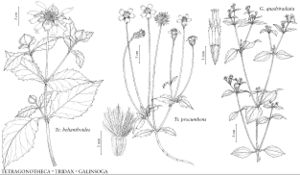Tridax
Sp. Pl. 2: 900. 1753.
Gen. Pl. ed. 5, 382. 1754.
| Taxon | Illustrator ⠉ | |
|---|---|---|
 | Tetragonotheca helianthoides Tridax procumbens Galinsoga quadriradiata | Yevonn Wilson-Ramsey Yevonn Wilson-Ramsey Yevonn Wilson-Ramsey |
Perennials [annuals], 10–40 [–80+] cm. Stems procumbent to ascending. Leaves basal and/or cauline; opposite; petiolate [sessile]; blades deltate, lanceolate, lanceovate, or ovate, often pinnately or palmately lobed, ultimate margins coarsely toothed to subentire, faces glabrate, hirsute, scabrellous, or strigillose. Heads radiate [discoid], borne singly [in ± cymiform arrays]. Involucres cylindric to hemispheric, 4–8 mm diam. Phyllaries persistent, 11–15+ in 2–3+ series (outer usually shorter, more herbaceous, the inner often scarious). Receptacles convex to conic, paleate (paleae ± persistent, lance-linear, scarious, weakly conduplicate, often apically toothed). Ray-florets [0–] 3–8 [–13], pistillate, fertile; corollas pale-yellow [white or purplish]. Disc-florets [20–] 40–80+, bisexual, fertile; corollas yellowish [whitish or purplish], tubes shorter than cylindric or funnelform throats, lobes 5, usually deltate [sometimes rays 0 and corollas of peripheral florets ± bilabiate]. Cypselae obconic to obpyramidal, 3-angled, 4-angled, or 5-angled, densely piloso-sericeous [glabrous, villous]; pappi [sometimes wanting in rays] persistent, of [10–] 20 [–40], plumose [ciliate], setiform scales. x = 10.
Distribution
Introduced; mostly tropical, mostly New World
Discussion
Species ca. 26 (1 in the flora).